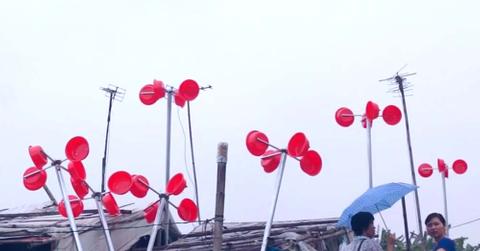This Vietnamese Village Is Powered From Broken Printers And Plastic Bowls
Hanoi university professor Le Vu Cuong may not have invented the light bulb, but he's given those that are poverty-stricken in Vietnam a little bit of free energy every day. The process involves recycled material and a cheaper electric bill for the inhabitants.
Updated May 24 2019, 3:13 a.m. ET

Most of us never stop to realize how much electricity is apart of our lives. It fuels everything we do from the alarms we set in the morning, to the power it gives our devices, and obviously the illumination it gives us in our workspaces and homes. For some countries, that potential is a luxury. Imagine having to budget a certain amount of it each day and limiting how much is really needed to survive. While a poor community in Vietnam is copying with this reality every day, they’ve happened to run into some light at the end of the tunnel.
Hanoi, the capital city of Vietnam, has its share of poor families that live on the outskirts of town. Some of them have gathered together along the coast of the Red River, taking advantage of boats and platforms that have been left over. They’ve created solid enough housing to put a roof over their head and survive. There’s electricity available in the area, but not much to go around. Those that do obtain it have to pay $9 per month, which is a hefty fee for them.
Looking for another avenue to bring in electricity, Professor Le Vu Cuong, who works at a university in Hanoi, was able to find a limited solution for all those dying for any energy they could get. The project would be to create wind turbines to generate electricity. While that process is commonly known for the massive farm systems located offshore, Cuong was able to dial it back with just a few utilities.
The professor and his team were able to find recyclable materials so they could avoid large costs. These turbines are made by sticking plastic bowls vertically on the end of old metal bars. These bars would intersect with pieces from a printer, which would then all be placed on another recycled metal bar. Power that is created then transfers into bike batteries.
Energy is limited to how much the wind blows, but it doesn’t have to be much. With the ability to just constantly churn at 0.89 miles per hour, the gadget can produce a substantial amount of energy, albeit for a few hours of light per night. While it may not sound like much, it’s substantial to the small village in this area. Marisa Pettit from Reset reports that normal costs “have already been cut by a third.”
Over 14 households have adopted the makeshift turbines and they can easily be seen scattered across the shore. More continue to be made as the resources come in. Creating this project was helped out by Live and Learn, Australian Ald, and Plan International Vietnam. The latter has been a mainstay since 1993 with a focus to provide children a better future.
This idea gives hope for other countries and the inhabitants that are struggling without power. There are only so many power stations that can be created, and they always to a number to the environment. This bit of clean energy can be the start of something spectacular.
